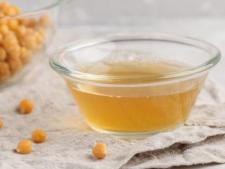-

aqua faba
| Food | Percentage of DRI per 100 grams | |
|---|---|---|
AQUAFABA is the water leftover from cooking legumes.
”Aqua” is latin for water and faba is latin for ”bean” It can be any kind of legumes such as chickpeas, mung beans, white beans, and black beans. But generally, the darker the bean, the stronger the flavor and color of the brine. So the best beans to use are lighter colored such as chickpeas, lima beans, cannelini and white beans. And best of all is chickpeas. You can use brine from canned or home cooked chickpeas.
We don’t yet have a chemical analysis of aquafaba. We know it consists of protein, carbohydrates and water. Egg whites consist of fat, protein and water.
The process started with someone named Miyoko Schinner using flaxseed mucilage to make vegan merengue. Aqua Faba itself was invented in March 2015. By Goose Wohlt. It was a huge deal in the vegan community.
What you can make
Marshmallows
Cookies
Cakes
Mayonnaise
Icing
Emulsifier in dressings, sauces and cheese
Frittata
Quiche
Butter
Cheese
Aqu faba is great for merengue, macaroons, cookies, but can not create custard, eclairs or egg white omelets (unless you add starches and stabilizers). Aquafaba can be used for emulsifying and foaming, but can not for coagulating or levening.
When you strain the chickpeas from the brine it is good to use fine mesh strainer to make sure there are no bean particles left in the brine, otherwis that can interfere with the emulsification process.
HOW TO COOK CHICKPEAS
2 cups chickpeas (soaked, rinsed and drained)
8 cups water
Simmer on low heat for 1-1 ½ hours until 2 1/2 cups water remains. Due to the variables of stove temperature, age of beans , the yield of aqua faba will vary slightly. Allow the beans to cool in the brine before straining.
In certain recipes the aquafaba needs to be reduced to minimize the water content. The reduced aquafaba helps the ingredients emulsify better and stabilizes the structure of the recipe.
REDUCED AQUAFABA
Add 1 cup aquafaba to a medium saucepan. Bring it to a boil and reduce it to a simmer over medium heat. Cook the aquafaba until it has reduced by half. Chill it in the fridge until thick and cold.
THINGS TO KNOW
- Make sure your bowl and whip or whisk are impeccably clean. Any oil or fat will interfere with developing the foam. Plastic bowls hold onto fats and are therefore not recommended for use.
- Smaller or larger amounts of aquafaba may take longer to whip than as directed.
- Whipping at slower speed will increase the time it takes to achieve firm or stiff peaks.
- If adding liquid fat to the whipped aquafaba, it will completely deflate unless the foam is at stiff peaks and the fat is added in a very slow, steady stream.
- Adding alcohol based extracts to a meringue will deflate it. Add extracts that do not contain alcohol and only add them once the meringue is stable at stiff peaks.
- Adding hot liquid, such as melted coconut oil will deflate the meringue to a certain extent, sometimes completely. Pay attention to the temperature, especially when using oil.
- Whipped merengue that has been deflated will rise in an oven set around 150 degrees celcius when combined with a starch and protein. For this reason, it is a normal occurrence to be instructed in recipes to deflate the meringue before baking.
- When aquafaba liquid is cooled it is more thick. The thickness of your aquafaba does not indicate how strong it is. Warm aquafaba is thin and cold is thicker. But it is just as effective. Your recipe is what determines whether you want the aquafaba cool, room temperature or warm.
- Egg whites can be substituted in a one-to-one ratio instead of aquafaba. (1 large egg white is about 2 tablespoons aquafaba)
- The amount of time it takes to whip your aquafaba depends on many things. How concentrated it is, how much of it there is, whether it is whipped with sugar, whether there is cream of tartar in the recipe. Just pay attention to the consistency called for in each recipe.
HOW TO STORE
Store in an airtight container in the refrigerator up to 7 days. Or freeze in ice cube trays, then pop into an airtight container.
WHIPPING AQUAFABA
1/2 cup aquafaba
Pinch of tartar, 1 teaspoon lemon juice, or 1 teaspoon vinegar
(acid that helps break down the protein and fluff it up into a whipped cream texture)
SOFT PEAKS (4 minutes)
Add the aquafaba and cream of tartar to the bowl of a stand mixer. Add the baloon whisk to the machine or use a hand mixer to whip the aquafaba for 4 minutes at medium speed until the peaks are soft and will melt back into the aqua faba.
FIRM PEAKS (9-10 minutes)
Increas the speed to medium-high speed and continue to whip for 5-6 minutes or until peaks form that will fall over into the shape of a birds beak. These are calle firm peaks.
STIFF PEAKS (13-14 minutes)
Continue to whip on medium-high speed for another 3-4 minutes. The aquafaba foam will begin climbing the sides of the bowl and will begin to look dry. Repeating the peak test will now result in a peak on the whip that will stand straigh up and not fall over at all. At this point you could even turn the bowl upside down and the thick foam will stay right in place. Unlike egg whites, you can not overwhip aquafaba, so when in doubt, continue to beat until you can be sure.